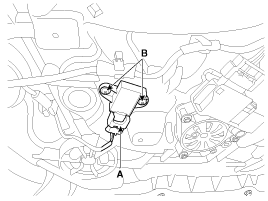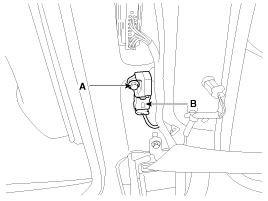| Pressure Side Impact Sensor |
|
1. |
Install the new pressure side impact sensor with the screws (B)
then connect the pressure side impact sensor connector (A).
Tightening torque :
2.5 ~ 3.5 N.m (0.25 ~ 0.36 kgf.m, 1.8 ~ 2.6 lb-ft)
|

|
• |
Use the specified screws surely.
|
|
|
|
2. |
Install the front door trim.
(Refer to the Body group - "Front door")
|
|
3. |
Reconnect the battery negative cable.
|
|
4. |
After installing the pressure side impact sensor, confirm proper
system operation:
| A. |
Turn the ignition switch ON; the SRS indicator light should
be turned on for about six seconds and then go off.
|
|
• |
You must comply with the specified tightening
torques with the tool specified because Pressure – Side
Impact Sensors (P-SIS) may be broken or POP-NUT may
be rotated.
|
|
• |
Problems may be occurred in the durability of
P-SIS or impact sensing performance may be depreciated
if POP-NUT is rotated.
|
|
• |
The door module must not be transformed because
SRSCM judges a impact through the pressure sensor in
the door module.
|
|
|
Side Impact Sensor
| •
|
Do not turn the ignition switch ON and do not connect
the battery cable while replacing the side impact sensor.
|
|
|
1. |
Install the new side impact sensor with the bolt (A) then connect
the side impact sensor connector (B).
Tightening torque:
7.8 ~ 9.8 N.m (0.8 ~ 1.0 kgf.m, 5.8 ~ 7.2 lb-ft)
|

|
|
2. |
Install the center pillar trim.
(Refer to the Body group - "Interior tirm")
|
|
3. |
Install the door scuff trim.
(Refer to the Body group - "Interior tirm")
|
|
4. |
Reconnect the battery negative cable.
|
|
5. |
After installing the Side Impact Sensor, confirm proper system
operation:
| A. |
Turn the ignition switch ON; the SRS indicator light should
be turned on for about six seconds and then go off.
|
|
Pressure Side Impact Sensor
•
Removal of the airbag must be performed according to the ...
Description
The STPS operates via a non-contacting magnetic proximity sensing device
combined with a simple electronic circuit resulting in the ability of producing
two separate and distinct ...
 Hyundai Elantra MD/UD: Installation
Hyundai Elantra MD/UD: Installation



